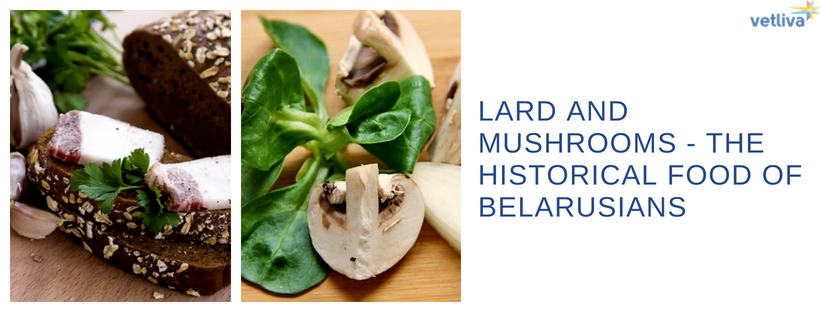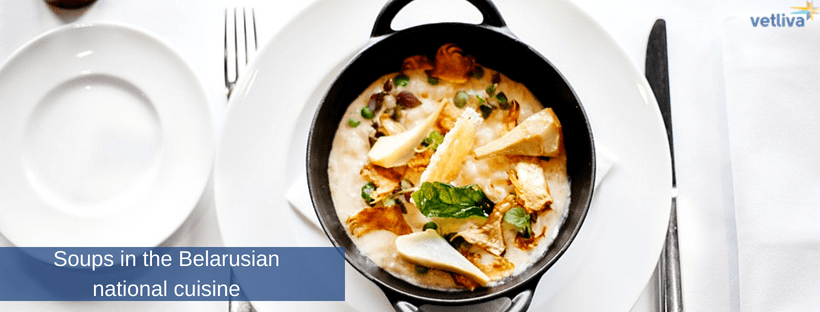Рецепты национальных белорусских блюд на английском языке. Тема по английскому языку "Belarusian cuisine"
Modern Belarusian cookery is based on old national traditions . Dishes from potatoes are very common in Belarusian cuisine. Potatoes are called «the second bread» in Belarus. There are special potato cafes in the country where you can try various potato dishes. Potatoes are included into many salads, served together with mushrooms, meat; different pirazhki (patties) and baked puddings are made from it. The most popular among the Belarusians are traditional draniki, thick pancakes, prepared from shredded potatoes. A lot of place in the diet of the Belarusians belongs to meat and meat products, especially to the pork and salted pork fat. Belarusians eat fresh, dried, salted and pickled mushrooms, and also berries such as bilberry, wild strawberries, raspberries, cranberry and some others. Zatirka is the most popular of flour dishes. Pieces of specially prepared dough are boiled in water and then poured over with milk . An integral part of any dinner is soup. It can be hot or cold. Belarusians are fond of borscht, a thick and rich beet and cabbage soup made with grains, potato and meat. The Belarusian khaladnik , a cold borscht made of beets, beet leaves and served with sour cream, hard-boiled eggs, and boiled potatoes will be pleasant on a hot summer day. Every possible salads are prepared from cabbage, carrots, beans. Bon appetit!
Do you like cooking?
No, to tell the truth I don’t like cooking. It takes a lot of time and frankly speaking I am not very good at cooking and my dishes are not always tasty.
What questions can you ask a friend who has invited you to a pot-luck party?
What dish shall I bring?
Where will the party take place?
Shall I bring some plates or cups?
Shall I bring some drinks?
Who else is invited to the party?
What questions can you ask a waiter when you are ordering a meal in a café?
What would you recommend me to order?
Have you got any vegetarian dishes?
What is the speciality of your café?
Is this dish rich in calories?
What national dish can you recommend a tourist to taste in Belarus ?
I would recommend to sample “ draniki” To my mind this dish is a speciality of our country, it is delicious. You can also taste borchs and holodnik.
Scientists say that fast food is unhealthy but teenagers can’t stop eating it. What do you think about it?
Personally I try to avoid fast food because it is high in calories but lacking in nutrition. Fast food is high in saturated fat and this type of fat is associated with a greater risk of cancer. What is more, eating a lot of fast food leads to high levels of cholesterol in the blood, which can cause heart diseases. Moreover, if you consume a lot of fast food you are likely to gain weight. So, I think teenagers should make an effort and try to limit the amount of fast food they eat.
Do you personally follow the rules of a healthy way of life? Why(not)? Yes , I personally try to follow the rules of a healthy way of life , I try to avoid junk food ,sweets, soda, eat more vegetables and fruit, have regular meals, spend some time in the open air, and take enough exercise.
Can you tell me how to cook one of your favourite dishes?
Frankly speaking I am not very fond of cooking but I can tell you how to prepare draniki.
First you should peel some potatoes, then you should grate them, add an egg , some flour, some salt, mix everything and make little pancakes on a frying pan . Serve your draniki hot with sour cream or butter. Bon appetite!
5.Most of the families want to have a big kitchen in the flat at the same time they have a meal together less and less often. What do you think about it?
To my mind it, is a pity if a family don’t have time to have a meal together because it could be a very nice tradition when people can become closer, share their experiences, learn more about each other’s lives and enjoy a delicious home-made meal. It also unites a family when the members of the family cook, lay the table, and wash up together. It is a pity in my family we seldom have meals together, we get together on some special occasions such as birthdays, holidays and I wish we could have more meals together.
What cafes would you recommend to visit in your place?
I would recommend you to visit sportcafe Pautina because the food is delicious there, you can eat sushi there, the food is not expensive, and the interior is modern and beautiful.
Do you know many recipes?
To tell the truth I am not fond of cooking , it takes a lot of time, and I am not good at it. So I cannot say that I know a lot of recipes but I think that if I need some recipe I will be able to find it on the Internet.
Сочинение на английском языке Белорусская еда/ Belarusian Food с переводом на русский язык
На английском языке. Belarusian Food
Belarusian cuisine is considered to be one of the most diverse cuisines in Europe. It has been largely influenced by Baltic, Slavic and even partially German cuisines. Traditional dishes of this country mainly consist of vegetables, meats and breads. Today, visitors of Belarus can try peasant cuisine of the countryside as well as the sophisticated dishes for the nobility. A traditional peasant meal has included a soup and a main course. One of the most delicious Belarusian soups is called “khaladnik”. It’s a cold type of borscht, which is mainly eaten in summer. This beetroot soup is eaten with sour cream. Potato is the main ingredient of many dishes. It is known as the second bread of Belarusians. Perhaps, everyone has heard of “draniki”. These are thick pancakes made of shredded potatoes. Meat is also widely used in Belarusian cuisine, especially pork. One of the traditional holiday dishes is called “pyachysta”. It is a delicious stew made of large chunks of pork or beef. Slightly smoked salty pork with onions and garlic is also popular. Most meat dishes in this country are served with potatoes or other vegetables. Historically, Belarus has little access to any type of seafood however there are some special fish-based dishes. For example, “yushka” - a fish soup boiled without any seasonings. In general, seasonings are not very popular in Belarusian cuisine. The most famous hard drink in Belarus is “harelka”. It’s similar to Russian vodka, but can be flavored with birch sap or forest herbs. Other traditional Belarusian drinks include kvass, beer, myadukha, etc. Traditional desserts, that are famous far beyond the country, are sweet pancakes with cottage cheese.
Перевод на русский язык. Белорусская еда
Белорусская кухня считается одной из самых разнообразных кухонь в Европе. На нее в значительной степени повлияли балтийские, славянские и даже частично немецкие кухни. Традиционные блюда этой страны в основном состоят из овощей, мяса и хлеба. Сегодня посетители Беларуси могут попробовать как крестьянскую кухню сельской местности, так и изысканные блюда для дворянства. Традиционная крестьянская еда включала суп и основное блюдо. Один из самых вкусных белорусских супов называется «холодник». Это холодная разновидность борща, которую в основном едят летом. Этот свекольный суп едят со сметаной. Картофель является основным ингредиентом многих блюд. Он известен как второй хлеб белорусов. Возможно, каждый слышал о «драниках». Это оладьи из измельченного картофеля. Мясо также широко используется в белорусской кухне, особенно свинина. Одно из традиционных праздничных блюд называется «пячысты». Это аппетитное тушеное мясо, приготовленное из больших кусков свинины или говядины. Слегка копченая соленая свинина с луком и чесноком также популярна. Большинство мясных блюд в этой стране подаются с картофелем или другими овощами. Исторически сложилось так, что Беларусь имеет ограниченный доступ к любым морепродуктам, однако есть и специальные рыбные блюда. Например, «юшка» - уха, которую готовят без каких-либо приправ. В целом, приправы не очень приветствуются в белорусской кухне. Самый известный крепкий напиток в Беларуси - это «горилка». Она похожа на русскую водку, но может быть приправлена березовым соком или лесными травами. К другим традиционным белорусским напиткам относятся квас, пиво, мядуха и т.д. Традиционный десерт, который известен далеко за пределами страны, это сладкие блинчики с творогом.
Belarusian national cuisine has existed for many centuries. It’s influenced by , geographical location, and climate. Agriculture causes using a lot of vegetables in cooking national dishes. Mostly, it was local food that was used in Belarusian cookery but there is a little influence fr om migrants fr om the bordering territories.
History of Belarusian cuisine
Recipes of other nations (Baltic, Jewish, German) appeared in Belarusian cuisine since existing of the Grand Duchy of Lithuania. For many centuries Belarusians didn’t consume a lot of meat but they ate lard as the Ukrainians did. It was pickled with its skin. As a substitute for meat there were mushrooms however at that time they were not pickled but dried.

Diary and sweet were almost not consumed in Belarusian cuisine. But there were sweet drinks such as kissel or shortening for a dessert.
Later on Belarusians used more meat in their ration. Usually meat dishes were cooked on holidays. The most popular kinds were pork, beef, poultry and game. Since that time there have been such dishes as machanka, verashchaka, smajanka, home sausages and pickled lard.

River fish was also widely used in national recipes. The most popular species were pike, sturgeon, blackhead, carp, perch, and zander. Soup and dumplings were prepared fr om fish.
Country cuisine was nutritious, simple and fresh. A lot of dishes were served to table being hot. Dishes for princes and gentry were more various and exotic. There were stuffed sanders and delicacy on magnates’ tables.
In Soviet Union times Belarusian cuisine was influenced by other nations. Ukrainian and Caucasian food was served in public places.
In the 20 th century a lot of Belarusian dishes were fr om wheat flour but not from rye as it was earlier. There were also a lot of salads.

Modern Belarusian cuisine
Nowadays it’s hard to use the same products as our ancestors did. Some vegetables and beans disappeared from our table. But many dishes have existed so far: pancakes, dumplings, pickles, kvass and beet soups, home sausages, lard, meat dishes.
Potato is an ingredient that exists in many Belarusian dishes. An average Belarusian eats a half of a kilo of potato every day. There are a lot of potato recipes such as draniki, baked puddings, babka, fried and stewed potato.
In Belarus meat is eaten twice as less than in Poland. By the way the most popular meat is not very useful but tasty pork.

The most popular meat dishes:
- bigos – stewed cabbage with meat;
- kolduny – potato fritters with meat;
- machanka – a sauce from different sorts of meat, served with pancakes;
- smajanka – meat pie.

As for alcohol drinks there are nastoykas from vodka, cranberry, honey such as zubrovka, crambambulya. Kvass and birch sap is also popular.
Deserts
Honey has been popular throughout all the history. Belarussians like pancakes with honey, honey cereals and pies. Soloduha (a sort of pastry), kissel, baked apples were cooked with honey.
Praniki is a sweet flour dish that was originally called “perniki”. People believe that it took its name from pagan times when people worshipped many gods and one of them was Perun, god of the Sun. At that time people brought something to Gods and especially figures of animals from sweet and tasty pastry. Later on the name changed as well as its taste because now they are made from wheat flour but not from rye.

Pancakes
Scientists still argue about the appearance of pancakes. There are several ideas. Some suggest that pancakes were baked from rye kissel. Another believe that the word ‘pancake’ appeared from the word “mlin” (mill). Earlier pancakes were baked from different sorts of flour. Now they are made mostly from wheat flour, yeast, milk, sour cream, kefir. Usually pancakes are eaten with various toppings, jam or honey.

Belarusian restaurants
You can taste national recipes at wh ere you can find a lot foreign guests who came to our country. There you can taste not only country dishes but also meals from princes’ tables.
There are a lot of and wh ere you can taste fresh baked bread, meat sausages, home cheeses, desserts from honey and fruits.
In a menu of Belorusian restaurants one can find not only our national cuisine but European, Caucasian and oriental dishes. Dishes cooked according to old recipes can be tasted during an , which you can book directly on our website.
However tourists should taste specific belarusian meals such as draniki, borshch, machnka, sour cabbage, pickled cucumbers, lard and national nastoykas.
All Belarusians like nutritious and tasty food. You can make sure if drop in one of the local restaurants.
In this article, we will tell you about ten great dishes that you realy want to try!
Zhurek
![]()
![]()
 Very interesting and unusual soup, which has its history since the time of Monomakh. One of the few Belarusian dishes where there is no potato in the recipe ?
Very interesting and unusual soup, which has its history since the time of Monomakh. One of the few Belarusian dishes where there is no potato in the recipe ?
The secret of the unique taste of soup in its leaven, prepared from oats and black bread. The leaven should be placed in a warm place for 2-3 days. Then the leaven is filtered and mixed with fatty meat, vegetables and garlic, after which it should be languished on fire. Having tried this unique soup, you would definitely want to cook it yourself, even if you do not like cooking.
Tukmachi
![]()
![]()
 The business card of the town of Kobrin is tukmachi. Something similar can be found on the territory of the whole country, but only in Kobrin tukmachi is cooked according to an old recipe.
The business card of the town of Kobrin is tukmachi. Something similar can be found on the territory of the whole country, but only in Kobrin tukmachi is cooked according to an old recipe.
Behind the rank-and-file name lies the usual potato casserole, but not everything is so simple. The main feature of tukmachis are onions, pre-fried in fresh fat, which are then added to the casserole during or after cooking. This unobtrusive detail gives the dish a special rustic taste. Tukmachi is served with salted curd and fresh milk.
To cook tukmachi it is enough to fry onions, and then in the same pan, evenly bake boiled mashed potatoes (preferably in the oven or on the grill). The recipe is simple, but the taste is still surprising with its versatility!
Galushki
![]()
![]()
 Galushki is a typical peasant dish, which nevertheless can become not only an excellent side dish, but also a full dish on your table.
Galushki is a typical peasant dish, which nevertheless can become not only an excellent side dish, but also a full dish on your table.
As soon as they serve soft and delicate galushki: with meat and garlic sauce, with condensed milk and melted butter, just with sour cream and greens or as an appetizer for soup with bread. In any case, behind their simple appearance there is an unforgettable taste that manifests itself in different ways (depending on the dishes with which they are savored).
It is not difficult to prepare this dish, it is enough to have flour, eggs and butter in hand, which are desirable to buy from a generous granny in the Belarusian village.
Tsibriki
![]()
![]()
 Tsibriki are hard to call a full-fledged dish, but it’s a good snack!
Tsibriki are potato balls with cheese filling, cooked in a frying pan. An unusual dish will be especially appreciated by beer fans, because crispy tsibriki with cold beer is the best combination for a friendly meeting.
Tsibriki are hard to call a full-fledged dish, but it’s a good snack!
Tsibriki are potato balls with cheese filling, cooked in a frying pan. An unusual dish will be especially appreciated by beer fans, because crispy tsibriki with cold beer is the best combination for a friendly meeting.
Nalistniki
![]()
![]()
 Nalistniki are popular pancakes in Belarus
, made from … unleavened egg-like liquid dough. In appearance, the nalistniki look like ordinary pancakes, but this is not quite so: compared to the usual pancakes , the nalistniki are much thinner and are used more for serving the dish than for forming the taste.
Nalistniki are popular pancakes in Belarus
, made from … unleavened egg-like liquid dough. In appearance, the nalistniki look like ordinary pancakes, but this is not quite so: compared to the usual pancakes , the nalistniki are much thinner and are used more for serving the dish than for forming the taste.
But what is so special about them then ? It’s all about stuffing! Sweet jam, tasty mushrooms, berries from the garden, homemade cottage cheese with raisins – these are just some options for toppings. But the main ingredient is the love with which this dish should be prepared ?
Sashni
![]()
![]()
 Another variation of the dish from potatoes is sashni. Sashni are small potato cutlets with cottage cheese stuffing. For cooking you will need an hour of free time and your enthusiasm.
Another variation of the dish from potatoes is sashni. Sashni are small potato cutlets with cottage cheese stuffing. For cooking you will need an hour of free time and your enthusiasm.
Ingredients you need are potatoes, eggs, flour and cottage cheese. Let’s start with potatoes: they must be boiled, and then mashed to a puree state. Then add flour and egg to the potato mix and mix thoroughly. After the cottage cheese is mixed with the egg and stacked on the cakes of potatoes (you must make them in advance:)), then one cake is covered with another, like a patty, and fried on both sides until golden brown.
The result – a delicate potato in combination with a soft curd literally melts in your mouth! This dish is especially popular with children.
![]()
![]()
 “Karavai, Karavai, choose the one you want!” – it’s the well-known children’s game, familiar to all Belarusians since childhood. For the Belarusian culture, the Karavai is not just a kind of bread.
“Karavai, Karavai, choose the one you want!” – it’s the well-known children’s game, familiar to all Belarusians since childhood. For the Belarusian culture, the Karavai is not just a kind of bread.
It is a symbol of hospitality and respect for those people for whom this loaf has been baked. The loaf has a rich, very mild taste, which is achieved by adding a large number of eggs and milk. Another feature of the Karavai is its unique appearance. And it’s not surprising!
After all, the tradition of giving a Karavai to a newly-married couple is still strong in Belarus. If you were given a Karavai, you must break off a piece, dip it in salt and try it.
Babka
![]()
![]()
 One of the most recognizable Belarusian dishes (in particular, thanks to a strange name) is a potato babka
(which means ‘old lady’). The dish that has been on both the peasants‘ and the princes’ table. In short, loved by all.
One of the most recognizable Belarusian dishes (in particular, thanks to a strange name) is a potato babka
(which means ‘old lady’). The dish that has been on both the peasants‘ and the princes’ table. In short, loved by all.
But what is special about a simple potato casserole called “babka”? The secret is simple: a cast-iron frying pan, natural products and languishes on the fire do their thing! Delicate potatoes with a light crust, combined with meat and sour cream, will be enjoyed even by those who consider such dishes “heavy.”
For cooking enough to grate the potatoes on a small grater, mix with finely chopped onions, pieces of brisket and salt, and then bake in a frying pan under the lid. The result will amaze you!
 This list would not be complete without mentioning the draniki – the most famous Belarusian dish.
Many mistakenly call them simply potato pancakes, but this is a great misconception. The classic recipe is extremely simple: from grated potatoes (pre-salted), make small “pancakes” and lay on a hot iron frying pan, with a generous amount of oil. At first glance, nothing special, but the taste!
This list would not be complete without mentioning the draniki – the most famous Belarusian dish.
Many mistakenly call them simply potato pancakes, but this is a great misconception. The classic recipe is extremely simple: from grated potatoes (pre-salted), make small “pancakes” and lay on a hot iron frying pan, with a generous amount of oil. At first glance, nothing special, but the taste!
Thin, slightly crunchy pancakes, despite their external miniature, can easily satisfy hunger. They are usually served with sour cream and greens.
These and many other dishes of Belarusian cuisine you can try in , and then go to the for new impressions. Bon Appetit!
Belarusian cuisine has centuries-long history, rich and interesting, and much in common with that of neighbouring Slavonic nations: Russians, Ukrainians and Poles. It’s influenced by the cuisine of Lithuania and Latvia, but has preserved its characteristics, using grain, potatoes, meat, milk and vegetables.
Belarusian cuisine widely uses potatoes
, the “second bread”
. Historically, potatoes were introduced to Belarus 75-90 years earlier than in Russia, and our climate facilitates the growth of many tasty varieties.
Grated potato is very common, and can be cooked in various ways, with methods combined. Belarusian cuisine often uses raw grated potato, shaped and fried: known as ‘tarkavanaja’ when used wet and ‘klinkovaja’ when drained. Mashed potato is sometimes combined with flour and baking soda. Traditional draniki
(potato pancakes) enjoy great popularity, served with sour cream, fried fat (pork rinds), mushrooms and various sauces.
People also cook “buĺbianiki”
(potato pies stuffed with various fillings) and “buĺbianaja babka”
(potato pudding). Pig guts can be stuffed with grated potato and then fried. Boiled potatoes are eaten unpeeled, as ‘saloniki’ (eaten with salt) while stewed potatoes are called ‘tušanka’ or ‘smažaniki’.
Cabbage, carrot, peas, beans and radishes
are typical of Belarusian cuisine.
“Sačni”
are pancakes made with flour, given various fillings, while fried ‘skavarodniki’ are made from vinegar dough, and eaten instead of bread.
Among flour and cereal dishes, the most popular are “zacirka”
(boiled dough, with milk or fat added); “kliocki”
(boiled dough, served with pork rind and onion, fried in fat); “kulieš”
(porridge from barley pea or bean flour); and “kulaha”
(porridge from rye or wheat flour and malt, served with honey or berries).
Thickened soups
prevail in Belarusian cuisine: “poliŭka”
(cereal and vegetable soup); “krupienia”
(thick millet soup); and «žur»
(an oat porridge which should turn sour before having milk (milk žur), fat, ‘viandlina’ and other products added).
According to the proverb, there’s no tastier fish than tench and no tastier meat than pork. Pork, beef and veal are widely used in Belarusian cuisine, while fried fat is the desired dressing for various flour and potato dishes. Homemade sausages
tend to be made of pork, while ‘viandlina’ is lightly smoked ham or pork loin.
Traditional meat dishes include “piačysta”
: boiled, stewed or fried cuts of young pig, rabbit or poultry or a large piece of pork or beef. Meanwhile, ‘vierieščaka’ (mačanka) are short ribs and sausages, stewed in water or kvass, brewed with flour, thick sour cream and onion sauce (as served with pancakes).
To make “vantrabianka”
, you boil offal, such as pig lungs, liver, hearts, kidneys or brains, before mincing and stuffing into pig intestine, to create a pudding. “Paliandvica”
is baked pork with spices. “Kalduny”
(potato pies) are stuffed with minced meat
(or other stuffing) and spices.
Mushrooms
are often used to garnish and add flavour. For instance, «žaronka»
is a meat dish stewed with vegetables and mushrooms, while “kapusnik”
is a cabbage soup with mushrooms.
Kvass
is a popular non-alcoholic drink, coming in several varieties: “biarozаvik”
is kvass from birch juice, while “klianovik”
uses maple juice, and “miadavucha”
is made from honey, with fermented berries and herbs. “Zbicień”
is a hot drink from honey and spices.
It should be noted that the most traditional national Belarusian dishes don’t use special ingredients. Rather, it"s the way that dishes are made that"s important: roasting, boiling, and stewing. Semi-liquid and semi-thick dishes are traditional for Belarusian cuisine, and serving dishes are often made from clay earthenware.
There are 12,179 cafes and restaurants operating at present in Belarus, seating 763,000. Of these, 7,599 are located in public places (seating 362,000).
Just 220 restaurants and cafes specialise in Belarusian national cuisine, and forty-five of these are found in Minsk. ‘Buĺbianaja’ café, ‘Kaliada’ café and ‘Buĺbaš’ café are located in the Mahilioŭskaja voblasć, while ‘Liamus’ restaurant, ‘Rodny Kut’ restaurant, ‘Usadba’ café and ‘Zadvinnie’ café are in the Viciebskaja voblasć. ‘Staroje Vriemia’ restaurant is well-known in Homieĺ, while ‘Ahinski’ restaurant, ‘Kamianica’ café, ‘U Francyska’ café, ‘Talaka’ bar, and ‘Kuchmistr’ restaurant are found in Minsk.
Not only their menus but their décor and utensils reflect our national cuisine traditions. In fact, all public catering sites are required to serve some national dishes (unless the establishment specialises in foreign cuisine).
Aiming to popularise our dishes, the Week of Belarusian Cuisine is held regularly, with restaurants and cafes offering national dishes, cooked to traditional recipes, using age-old methods. Every establishment is then obliged to charge the same price for the dish, regardless of the restaurant or café.
Mushroom soup and Belarusian soup are very popular, as are ‘zacirka’, ‘kapusnik’, ‘draniki’, ‘mačanka’ (a meat-based stew), ‘buĺbianaja babka’ (potato pudding), ‘mannik’ (manna cake), ‘buĺbianiki’, ‘vierieščaka’ and potato kliocki.





